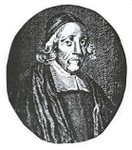Aspects of Piety 02
As for the man himself, scant detail regarding his life outside the pulpit exists. Moira Baker says ‘ … the eclipse of his reputation belies the achievement of his earlier career and his enduring stature as a gifted preacher.’ ‘The man we cannot see,’ wrote Joseph Angus in 1866 ‘nor have we found a witness that has seen him’. Or as W H Stowell put it 20 years before, ‘His only monument is in his works. (See here.)
Our ignorance is so great that we know neither where or when he was born, nor when he died. The ODNB guesses 1583-1652.
Our ignorance is so great that we know neither where or when he was born, nor when he died. The ODNB guesses 1583-1652.
It was uncertain at one time whether he was a university man but evidence has apparently surfaced to say that he went to Trinity College, Cambridge, in 1598 from where he graduated BA in 1601 (see here) and gained an MA in from Clare College (then Clare Hall) in 1606 (see here). This fits with his remark about universities being ‘nurseries of Christian learning’ (Works 2, p 112. Also note ‘For only about 5 per cent (38) of the [London] lecturers is there good reason to suppose that they did not attend university at all.’ Paul Seaver, The Puritan lectureships the politics of religious dissent 1560-1662, Stanford, California, Stanford UP, 1970, p 181).
We also know that at some point he married and had a son and two daughters, the latter predeceasing him in 1642 and 1647. Probably he was born in the early 1580s, in the reign of Elizabeth I. (It is clear from his occasional references to her that Adams respected good Queen Bess and King James too). As for his death, we know that in 1652 he was in ‘necessitous and decrepit old age’. (Cf Works 3, pp lvi and 264). It would seem that he ‘relied upon the charity of his former parishioners during the final months of his life’ which presumably came while in his seventies, before the Restoration of 1660.
A further known date is his ordination in the Diocese of Lincoln in 1604, the year after James came to the throne. The following year Adams was licensed to the curacy of Northill, Bedfordshire, but was soon dismissed when Northill College Manor was sold. (See here). By 1611 it seems he was vicar in the village of Willington, near Bedford, where he remained until 1614, pursuing a ministry of preaching and putting sermons into print. (See here). While at Willington, he preached at least once before the Bedford clergy at an Archdeacon’s visitation and twice from Paul’s Cross. These sermons were published, as was the common practice at the time. So even as a young man his sermons were being published
We also know that at some point he married and had a son and two daughters, the latter predeceasing him in 1642 and 1647. Probably he was born in the early 1580s, in the reign of Elizabeth I. (It is clear from his occasional references to her that Adams respected good Queen Bess and King James too). As for his death, we know that in 1652 he was in ‘necessitous and decrepit old age’. (Cf Works 3, pp lvi and 264). It would seem that he ‘relied upon the charity of his former parishioners during the final months of his life’ which presumably came while in his seventies, before the Restoration of 1660.
A further known date is his ordination in the Diocese of Lincoln in 1604, the year after James came to the throne. The following year Adams was licensed to the curacy of Northill, Bedfordshire, but was soon dismissed when Northill College Manor was sold. (See here). By 1611 it seems he was vicar in the village of Willington, near Bedford, where he remained until 1614, pursuing a ministry of preaching and putting sermons into print. (See here). While at Willington, he preached at least once before the Bedford clergy at an Archdeacon’s visitation and twice from Paul’s Cross. These sermons were published, as was the common practice at the time. So even as a young man his sermons were being published







No comments:
Post a Comment